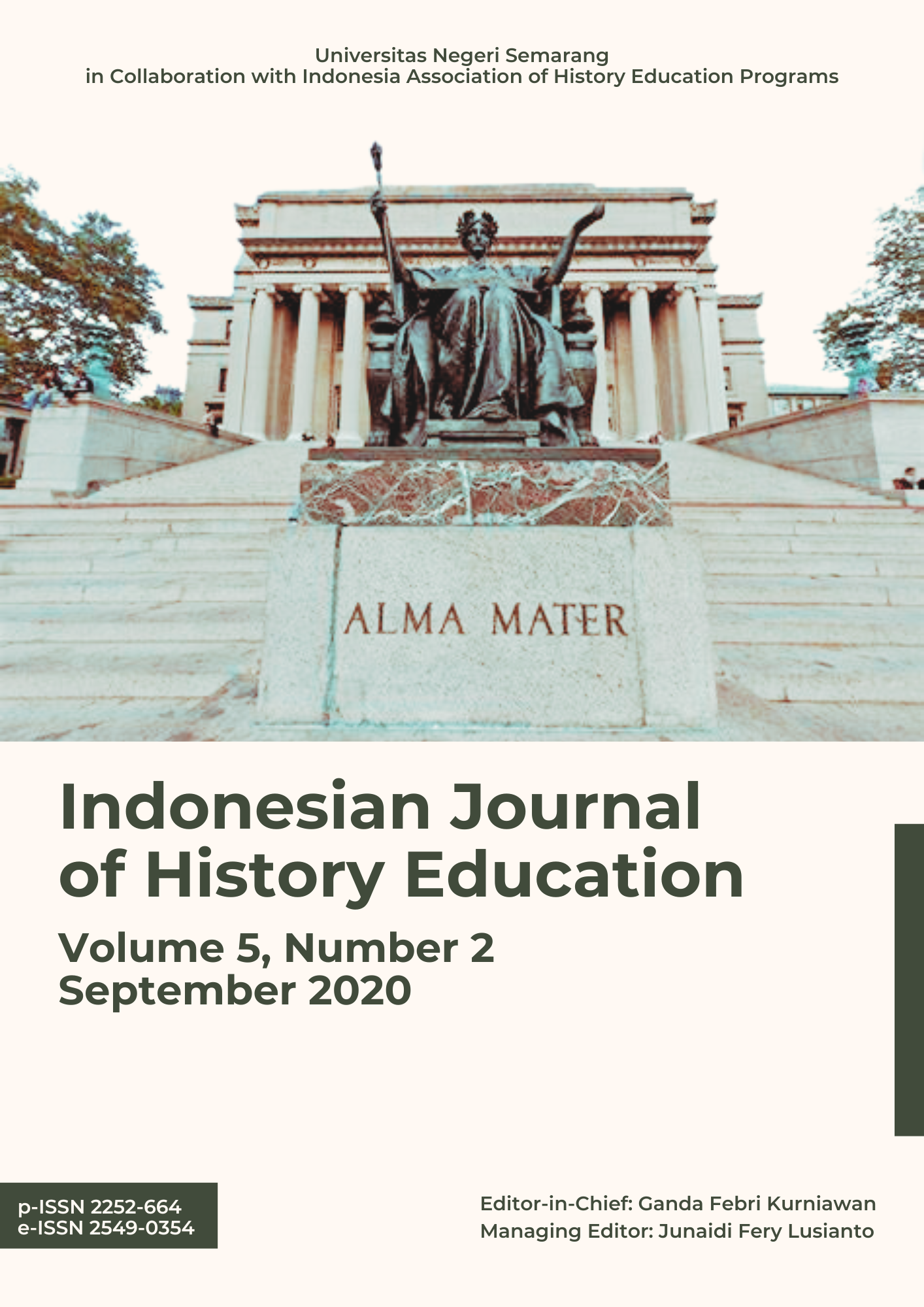The Effect of the Use of Quipper School-Based Indonesian History E-Learning Learning Media on the Interest and Learning Outcomes of Class X Students of SMK N 04 Kendal
Abstract
The purpose of this research was 1) to know the interest and learning outcome of the tenth graders at SMK N 04 Kendal before using e-learning quipper-based history learning media, 2) to know the difference in student interest and learning outcomes that use and who do not use e-learning media based on quipper school 3) to know the effect of using e-learning quipper school-based as history learning media towards the interest and learning outcome of the tenth graders at SMK N 04 Kendal. This research was experimental, using a quasi-experimental design with a nonquivalent control group design and survey method. The results of this research show that there is before using e-learning media based on Quipper's interest in learning, the average score of students' learning interest in the class was 67.83 with sufficient category and student learning outcomes before using e-learning media based on Quipper school is still under KKM (Minimal Mastery Criteria) 25.97 for pretest control class and 37.36 for pretest experiment class. The results t-test of students' learning interest shows a t value count as much as 9.084> 1.994 (t table), and the results t-test of students' learning outcomes shows t value count as much as 6.587 > 1.994 (t table). Therefore, there is a difference in interest and learning outcomes in the classroom that use and who do not use e-learning media based on Quipper school—using e-learning Quipper school-based history learning media towards students’ interest 40,3% and students’ learning outcomes as much as 27,5%. Therefore, the use of e-learning quipper school-based history learning media influences the interest and learning outcomes of the tenth graders at SMK N 04 Kendal.
References
Asmani, J. M. M. (2016). Effective Cooperative Learning Tips: Active, Creative, and Not Boring Learning. Diva Press.
Atno, A. (2011). The effectiveness of interactive CD media and VCD media on the learning outcomes of history students of State High School in Banjarnegara is reviewed from the level of learning motivation. Paramita: Historical Studies Journal, 21(2).
Basuki, A. T., & Nazaruddin, I. (2015). Statistical analysis with spss. Yogyakarta: Danisa Media, 51.
Daryanto. (2010). Learning Media. Yogyakarta: Gava Media
Gani, I., & Amalia, S. (2015). Data Analysis Tools: Application of Statistics for the Study of Economic and Social Fields. Publisher Andi.
Gunawan, C. (2018). Proficient in mastering SPSS (Easy to process data with IBM SPSS Statistic 25). Deepublish.
Gunawan, F. A. (2014). Analysis of the influence of television advertising and endorsers on purchase intention with brand awareness as an intervening variable. Journal of Marketing Strategy, 2(1), 1-14.
Kochhar, S. K. (2008). History Learning. Jakarta: Translators Purwanta and Yopita Hardiwati. Grasindo
Mais, A. (2016). Learning media for children with special needs (ABK): Reference books for teachers, students, and the general public. Pustaka Abadi.
Marbun, S. M., Th, S., & PdK, M. (2018). Educational psychology. Uwais Inspirasi Indonesia.
Muammar, M., & Suhartina, S. (2018). Information technology-based learning media is increasing interest in learning moral beliefs. CURIOSITY: Social and Religious Communication Media, 11(2), 176-188.
Ngafifi, M. (2014). Technological advances and human lifestyles from a socio-cultural perspective. Journal of Educational Development: Foundations and Applications, 2(1).
Pratiwi, N. K. (2015). The effect of education level, parental attention, and student interest in learning on the achievement of learning the Indonesian language for health vocational school students in Tangerang City. Poet: Journal of Language and Literature, 1(2), 31-31.
Purwanto. (2009). Evaluation of Learning Outcomes. Yogyakarta: Student Library.
Riyanto, P. D. L. (2011). Yogyakarta Educational Information Technology : Gava Media.
Sardiman. (2011). Interaction and Motivation of Teaching and Learning. Jakarta: Raja Grafindo Persada.
Slameto. (2010). Learning and the Factors That Influence It. Jakarta: Rineka.
Sugiyono, S. (2015). Educational research methods: (quantitative, qualitative, and R&D approaches). Bandung: Alfabeta.
Susanti, R. (2005). Sampling in educational research. Journal of Technodics, pp. 187–208.
Syah, M. (2001). Educational psychology with a new approach. Yogyakarta: Rosda.
Syahri, A. A. (2014). Education Statistics. SIGMA (Intellectual Voice of Mathematical Style), 6(2), 127.
Wahyono, A. (2019). The Effect of Service Quality, Facilities, and Price Perception on Student Satisfaction at Satya Negara University Indonesia Campus A. Journal of Management, 4(1), 16–27.
Wahyudi, D., & Azizah, H. (2016). Fun learning strategies with the concept of learning revolution. Attarbiyah, 26, 1-28.
Zazin, N., & Zaim, M. (2019). Social Media-Based Islamic Religious Learning Media in Generation-Z. In Proceedings Antasari International Conference (Vol. 1, No. 1).
Copyright (c) 2020 Indonesian Journal of History Education

This work is licensed under a Creative Commons Attribution 4.0 International License.
Copyright Notice
An author who publishes in the Jurnal Indonesian Journal of History Education agrees to the following terms:
- Author retains the copyright and grants the journal the right of first publication of the work simultaneously licensed under the Creative Commons Attribution-ShareAlike 4.0 License that allows others to share the work with an acknowledgement of the work's authorship and initial publication in this journal
- Author is able to enter into separate, additional contractual arrangements for the non-exclusive distribution of the journal's published version of the work (e.g., post it to an institutional repository or publish it in a book) with the acknowledgement of its initial publication in this journal.
- Author is permitted and encouraged to post his/her work online (e.g., in institutional repositories or on their website) prior to and during the submission process, as it can lead to productive exchanges, as well as earlier and greater citation of the published work (See The Effect of Open Access).
Read more about the Creative Commons Attribution-ShareAlike 4.0 Licence here: https://creativecommons.org/licenses/by-sa/4.0/.




